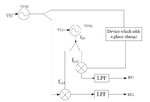per_lube
Advanced Member level 4
Hi,
I want to measure the phase difference between two RF signals of a receiver circuit.
Can I use Network Analyzer (VNA) for this measurement? or is there any other technique that can be used to measure the phase difference of two RF signals in the laboratory?
regards,
I want to measure the phase difference between two RF signals of a receiver circuit.
Can I use Network Analyzer (VNA) for this measurement? or is there any other technique that can be used to measure the phase difference of two RF signals in the laboratory?
regards,
